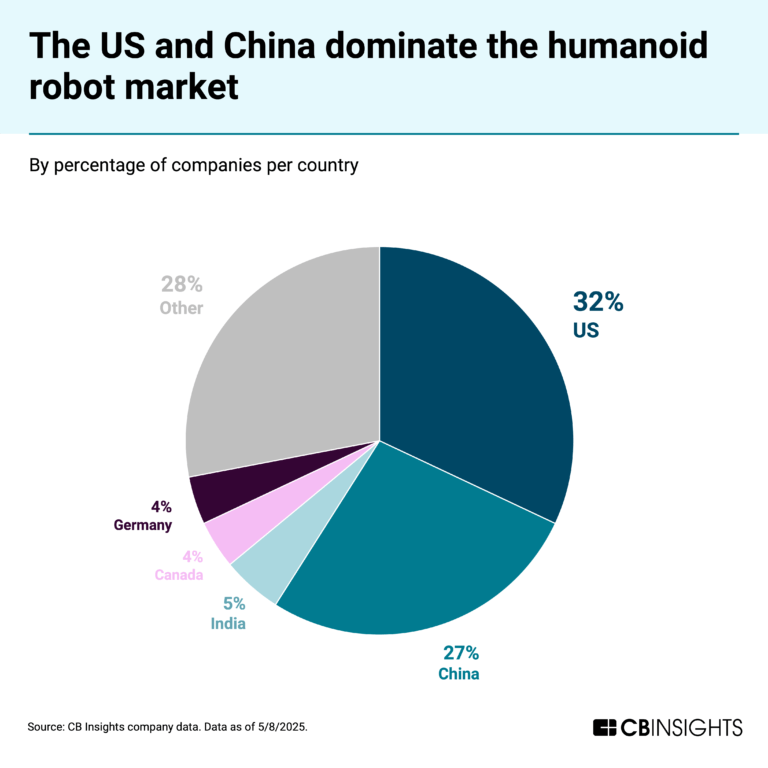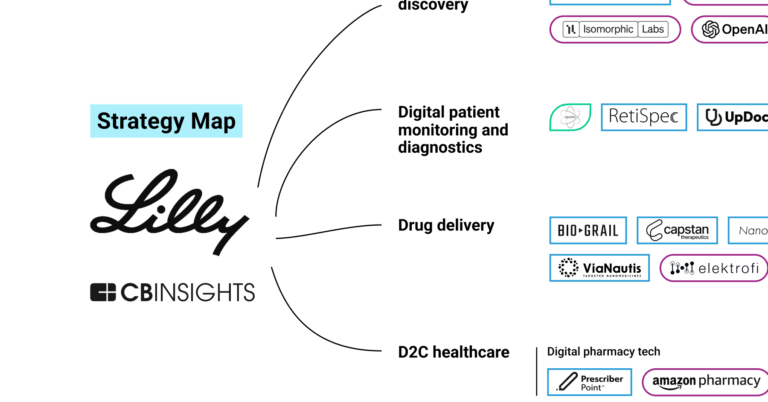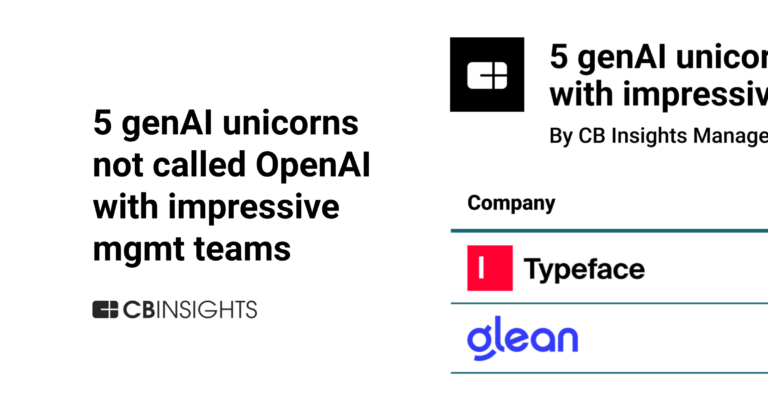
Google DeepMind
Founded Year
2010Stage
Angel - II | AliveAbout Google DeepMind
Google DeepMind is an artificial intelligence research company focused on AI across various sectors. The company develops generative AI models for creating images, music, and videos, and conducts research in health, climate, and quantum computing. Google DeepMind was formerly known as DeepMind. It was founded in 2010 and is based in London, United Kingdom. In January 2014, Google DeepMind was acquired by Google at a valuation between $500M and $650M.
Loading...
ESPs containing Google DeepMind
The ESP matrix leverages data and analyst insight to identify and rank leading companies in a given technology landscape.
The humanoid robot foundation model developers market focuses on companies creating large-scale pre-trained AI models specifically designed for enhancing the cognitive and interactive abilities of humanoid robots. These specialized foundation models enable robots to perform complex perception, reasoning, and execution tasks in real-world environments across manufacturing, logistics, healthcare, an…
Google DeepMind named as Outperformer among 11 other companies, including Meta, Microsoft, and Baidu.
Loading...
Research containing Google DeepMind
Get data-driven expert analysis from the CB Insights Intelligence Unit.
CB Insights Intelligence Analysts have mentioned Google DeepMind in 9 CB Insights research briefs, most recently on Jun 26, 2025.
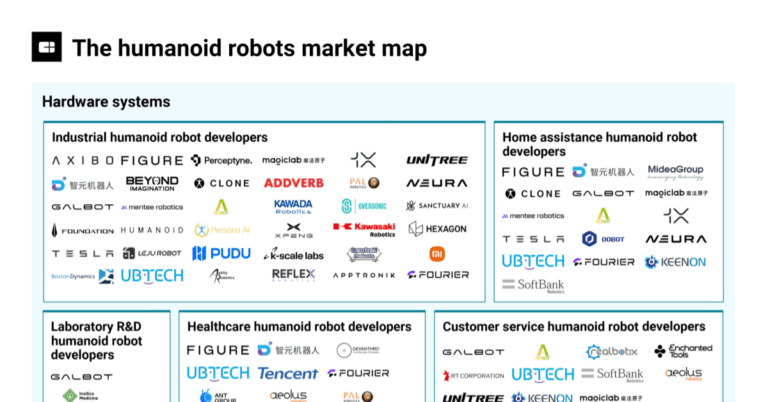
Jun 26, 2025
The humanoid robots market map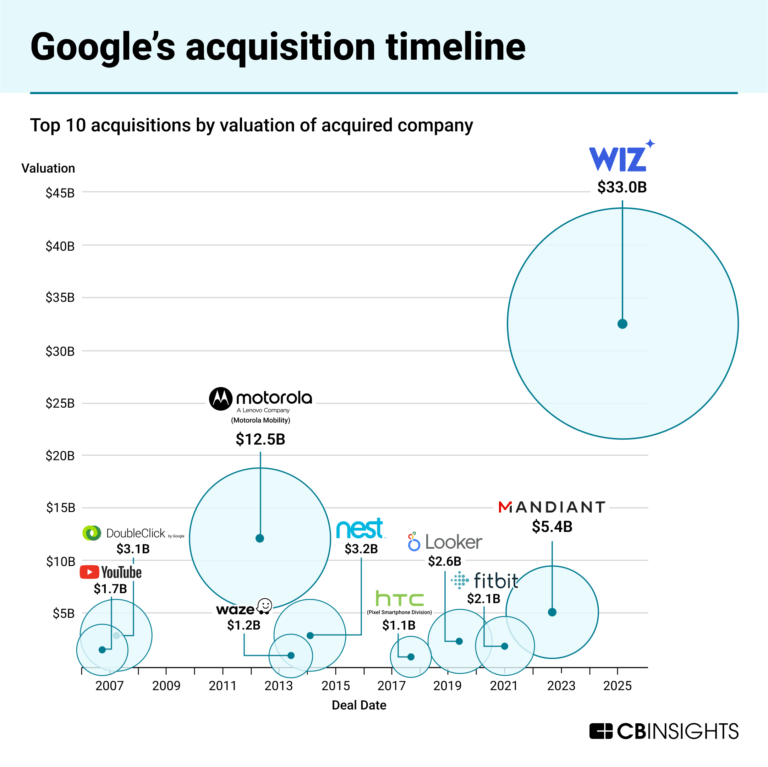
Mar 20, 2025
Google’s biggest acquisitions
Jul 2, 2024 team_blog
How to buy AI: Assessing AI startups’ potential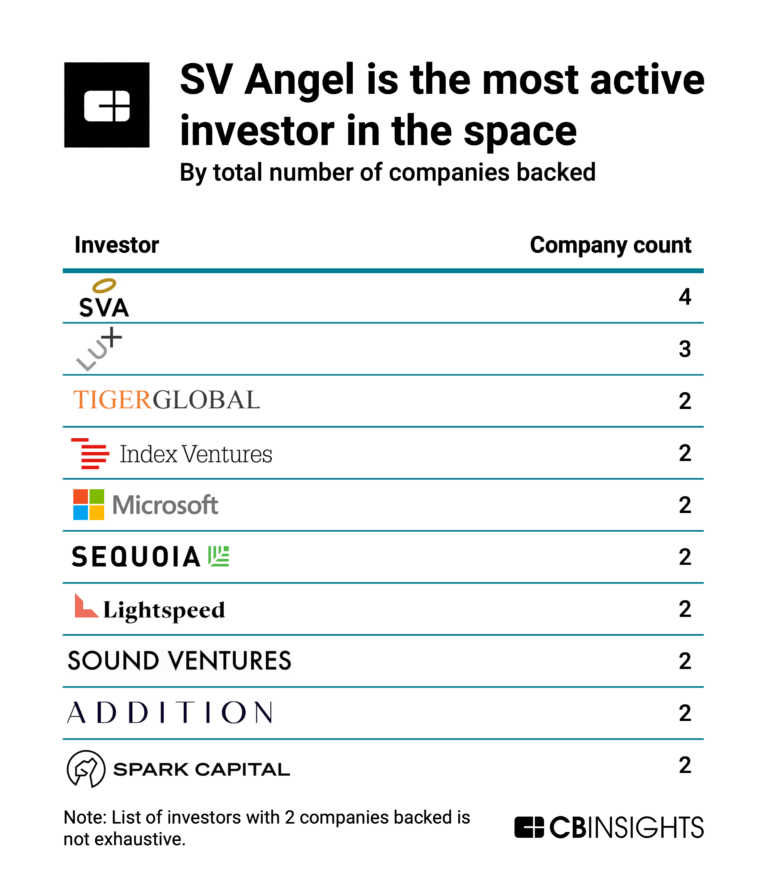
Jul 14, 2023
The state of LLM developers in 6 charts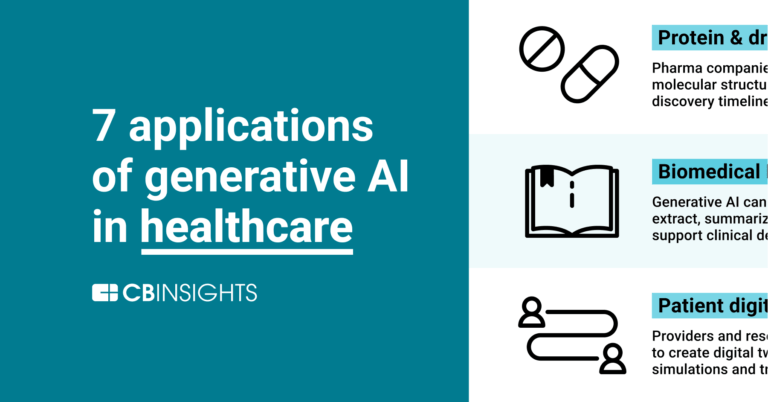
May 9, 2023
7 applications of generative AI in healthcareExpert Collections containing Google DeepMind
Expert Collections are analyst-curated lists that highlight the companies you need to know in the most important technology spaces.
Google DeepMind is included in 4 Expert Collections, including Artificial Intelligence.
Artificial Intelligence
12,580 items
Companies developing artificial intelligence solutions, including cross-industry applications, industry-specific products, and AI infrastructure solutions.
Advanced Manufacturing
4,474 items
Companies in the advanced manufacturing tech space, including companies focusing on technologies across R&D, mass production, or sustainability
Generative AI
2,799 items
Companies working on generative AI applications and infrastructure.
AI Agents & Copilots Market Map (August 2024)
322 items
Corresponds to the Enterprise AI Agents & Copilots Market Map: https://app.cbinsights.com/research/enterprise-ai-agents-copilots-market-map/
Google DeepMind Patents
Google DeepMind has filed 515 patents.
The 3 most popular patent topics include:
- artificial neural networks
- machine learning
- artificial intelligence

Application Date | Grant Date | Title | Related Topics | Status |
|---|---|---|---|---|
3/8/2023 | 4/8/2025 | Mathematical optimization, Artificial neural networks, Numerical differential equations, Optimization algorithms and methods, Artificial intelligence | Grant |
Application Date | 3/8/2023 |
|---|---|
Grant Date | 4/8/2025 |
Title | |
Related Topics | Mathematical optimization, Artificial neural networks, Numerical differential equations, Optimization algorithms and methods, Artificial intelligence |
Status | Grant |
Latest Google DeepMind News
Sep 9, 2025
When most teams talk about “AI or data risk,” the conversation always drifts toward accuracy, data quality, or scaling infrastructure. Important, sure. But almost never the real reason projects collapse. The truth is more uncomfortable: AI and data projects die not in the lab, but in the org chart. I’ve seen this firsthand in projects that looked technically flawless but never landed in the business. Gartner’s data confirms it — lack of alignment, change management, and ownership are the real killers. If you need more proof, just look at IBM Watson Health. The system was hailed as a revolution in oncology. It was pitched as a doctor’s assistant that could recommend treatments with near human accuracy. The technology itself was impressive, but hospitals struggled to integrate it. Doctors distrusted the recommendations, workflows were not redesigned, and leadership often treated it as a bolt on experiment rather than a strategy. By 2022, IBM sold Watson Health for parts. Not because the models failed in the lab, but because the adoption gap was never closed in practice. Case 1: A Model Nobody Used A few years ago, I worked on a major data initiative: consolidating reporting frameworks to create a single source of truth. On paper, it had everything — a strong business case, clear demand for harmonizing data, and even the CEO’s backing. But in practice, almost nobody used it for its designed purpose. Over 90% of reports were still being built in Excel after the product launch. Looking back, the problem was not technical. The BI models worked fine, and the data pipelines delivered what we promised. We had even designed for very high accuracy by making it more dependent on humans in the loop and having a final say. The real challenge was sociology: Teams weren’t ready to change their reporting habits and we were not integrating products seamlessly in their day-to-day flow. Leaders weren’t aligned on what “success” actually meant. Legacy ways of working kept pulling people back into old workflows. That project taught me a hard lesson: even the best-designed data projects and models are worthless without adoption. Technology solves problems in theory, but it’s organizational behavior that decides whether it lives or dies. Case 2: An Imperfect Start That Scaled Not long after, I saw the opposite play out. For another AI product that I helped, the launch started rough. This was a transformative project for building recommendation systems . The model and the architecture was not the best it could be, but priority was given to deployment and adoption of the MVP version and gathering proof in multiple markets! But this time, leadership made adoption non-optional. Accuracy was tracking alone side adoption and revenue, and everyone was aligned on the KPIs. Rollouts were phased so one shaky market did not doom the whole initiative. Training and incentives were built in. Strategy was clear — to be in a position to learn and iterate fast on the MVP version and scale it globally. Because the organization persisted — and treated it as strategy, not a side experiment, adoption grew. And the product scaled and proved value, and was optimised in coming months. Within a year, it was live in a few markets and contributed over ten million euros in uplift. That experience made the contrast clear: success depended less on precision, and more on persistence and people. The A.D.O.P.T. Framework for Closing the AI Adoption Gap I have come to think of the core challenge as the Adoption Gap — the yawning space between what a model can do and what an organization is willing to change. Closing this gap is critical. Accuracy without adoption is a Ferrari on dirt roads: impressive on paper, but useless in practice. AI projects succeed not because of perfect models, but because organizations embrace them. Based on my experience, I have started asking these five fundamental questions before and during execution — it’s never too late! These questions directly correspond to the five pillars of the A.D.O.P.T. framework, set of questions I would clarify and align on and re-check at multiple times for the duration of the project and use this framework to escalate for help. Alignment (A): Are we aligned on what success actually means? Without shared metrics, teams with conflicting definitions of success will pull the project apart. Design for People (D): Why will people use this? The solution must be designed for real-world users and embedded in their existing workflows to avoid the friction that kills adoption. Ownership & Persistence (O): Who owns adoption, and is leadership treating this as a long-term strategy rather than a flashy experiment? Without sustained ownership and commitment, even promising pilots will be abandoned. Precision with Purpose (P): Is the model good enough to solve a real problem and deliver value now? The goal is to be fit for purpose, not to chase marginal gains in accuracy at the expense of ROI. Transparency (T): Is progress communicated well and openly? Highlighting successes, acknowledging limitations, and sharing results keeps teams aligned and leadership engaged. ADOPT in the Real World ✅Success When All 5 Pillars Line Up: Recommendation System Rollout in my experience (case 2 above) When I helped launch a recommendation system , the initial model was basic and end-to-end architecture wasn’t the best it could have been. The main focus was on rollout and adoption Alignment: KPIs were explicit — adoption rates and revenue uplift, not just model accuracy. Design for People: Recommendations were embedded directly into existing shopping flows, so users didn’t need to change behavior. Ownership & Persistence: A clear owner tracked adoption milestones, and leadership backed the rollout across multiple markets, even when one pilot was shaky. Purposeful Precision: It was shipped at “good enough”, proving ROI first and optimizing and expanding later. Transparency: Phased results were shared openly, which kept teams aligned and leadership engaged. Because adoption was treated as strategy and not a side experiment — the system scaled globally and delivered measurable value. Parallels: Amazon built their growth engines the same way. They launched early, focused on adoption, and iterated into world-class recommenders. When Amazon came to the Netherlands, I distinctly remember being frustrated at the recommendations, but it improved a lot since iteratively! ❌ Where It Falls Apart Alignment: DeepMind’s NHS Streams kidney-injury tool was technically strong, but success was never defined the same way for doctors, regulators, and patients. Without shared KPIs, adoption collapsed despite accuracy ( The Guardian , Cambridge ). Also, this was the same case with the reporting project I mentioned. However, in later iterations, alignment was focused on, and it was rolled out successfully to over twice the number of markets than initially envisioned. Design for People: Microsoft Tay showed what happens when AI isn’t designed for real-world users. Launched on Twitter without safeguards, it was hijacked within hours and shut down ( BBC ). Ownership & Persistence: As mentioned above, IBM Watson for Oncology lacked clear ownership in hospitals. Doctors distrusted it, admins didn’t enforce it, and IBM leadership abandoned it after shaky pilots ( STAT News ). Purposeful Precision: Zillow Offers chased predictive accuracy in home prices but ignored workflow fit and seller adoption. Billions lost when the model didn’t translate to practice ( CNBC ). Transparency: COMPAS, a recidivism risk scoring tool in US courts, operated as a black box. When bias concerns surfaced, lack of transparency destroyed trust and legitimacy ( ProPublica ). Takeaway The biggest risk in AI isn’t accuracy — it’s adoption. Models can be built in weeks, but changing how people work takes years.That’s why even brilliant models fail when just one pillar of ADOPT is missing, and why imperfect ones succeed when all five are in place. The rule of thumb is simple: PMs make adoption visible with data. Leaders make adoption real with persistence. Miss either, and the gap stays open.So next time someone asks, “How accurate is the model?”, ask instead: “Are we ready to adopt it? Join thousands of data leaders on the AI newsletter . Join over 80,000 subscribers and keep up to date with the latest developments in AI. From research to projects and ideas. If you are building an AI startup , an AI-related product, or a service, we invite you to consider becoming a sponsor .
Google DeepMind Frequently Asked Questions (FAQ)
When was Google DeepMind founded?
Google DeepMind was founded in 2010.
Where is Google DeepMind's headquarters?
Google DeepMind's headquarters is located at 5 New Street Square, London.
What is Google DeepMind's latest funding round?
Google DeepMind's latest funding round is Angel - II.
Who are the investors of Google DeepMind?
Investors of Google DeepMind include Elon Musk, Google, Horizons Ventures, Jaan Tallinn, Founders Fund and 4 more.
Who are Google DeepMind's competitors?
Competitors of Google DeepMind include Humanloop, OpenAI, xAI, Centific, Asteromorph and 7 more.
Loading...
Compare Google DeepMind to Competitors

MI2.ai focuses on machine learning predictive models in the data science and artificial intelligence sectors. The company provides services related to responsible machine learning practices, including research and consulting. It serves the academic community and businesses interested in implementing AI practices. The company was founded in 2016 and is based in Warszawa, Poland.

Sakana AI focuses on developing artificial intelligence (AI) through nature-inspired foundation models within the research and development sector. Its main offering includes creating a new kind of foundation model that draws inspiration from natural intelligence, designed to advance the field of AI. It was founded in 2023 and is based in Tokyo, Japan.

OpenAI offers artificial intelligence (AI) research and deployment that focuses on ensuring that AI benefits all of humanity. Its main offerings include developing AI technologies with a commitment to safety, alignment with human values, and broad societal benefits. Its products and services are designed to address global challenges and promote the equitable distribution of AI advantages. It was founded in 2015 and is based in San Francisco, California.

Inflection AI focuses on enterprise artificial intelligence, providing artificial intelligence (AI) model training and tuning while addressing data security and cost efficiency for enterprise clients. The company's solutions integrate into business operations. It was founded in 2022 and is based in Palo Alto, California.

Cohere operates as an enterprise artificial intelligence (AI) company building foundation models and AI products across various sectors. The company offers a platform that provides multilingual models, retrieval systems, and agents to address business problems while ensuring data security and privacy. Cohere serves financial services, healthcare, manufacturing, energy, and the public sector. It was founded in 2019 and is based in Toronto, Canada.

Anthropic focuses on artificial intelligence (AI) safety and research within the artificial intelligence sector. It offers AI models, including Claude Opus 4, Claude Sonnet 4, and Claude Haiku 3.5, for various applications such as coding, customer support, and education. The company primarily serves sectors that require AI solutions, including technology, education, and customer service industries. It was founded in 2021 and is based in San Francisco, California.
Loading...

